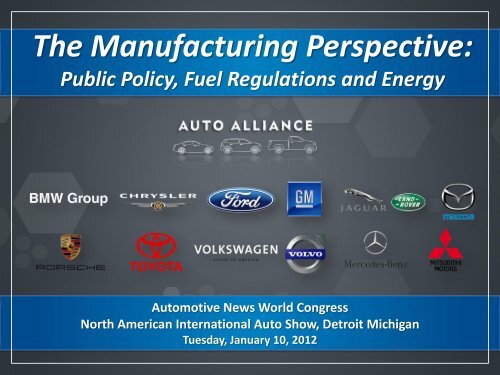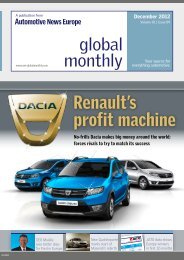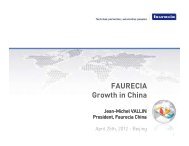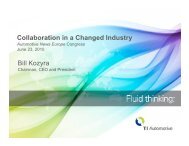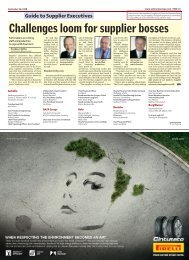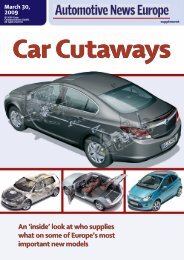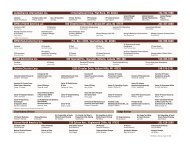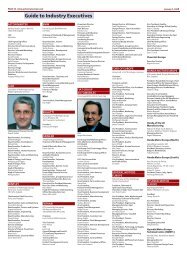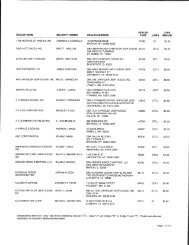The Manufacturing Perspective - Automotive News
The Manufacturing Perspective - Automotive News
The Manufacturing Perspective - Automotive News
You also want an ePaper? Increase the reach of your titles
YUMPU automatically turns print PDFs into web optimized ePapers that Google loves.
<strong>The</strong> <strong>Manufacturing</strong> <strong>Perspective</strong>:<br />
Public Policy, Fuel Regulations and Energy<br />
<strong>Automotive</strong> <strong>News</strong> World Congress<br />
North American International Auto Show, Detroit Michigan<br />
Tuesday, January 10, 2012
Ten Key Points<br />
(1) Automakers are making significantly cleaner, safer and more energy-efficient autos;<br />
the public gets it.<br />
(2) Auto industry is seen as progressive on the environment.<br />
(3) In today’s world, the public puts growth over the environment.<br />
(4) Consumers enjoy an expanding range of options for energy-efficient technologies,<br />
including advancements in ICEs.<br />
(5) Consumers prefer to motivate fuel efficiency gains themselves.<br />
(6) Automakers invest billions in R&D… with only 1% from government.<br />
(7) To meet new federal standards, consumers will need to buy fuel-efficient vehicles in<br />
higher volumes / ratios.<br />
(8) <strong>The</strong> U.S. is a different marketplace than Europe – especially vis-à-vis diesel.<br />
(9) A multi-sector approach to energy policy is crucial to success.<br />
(10) Consensus on goals and fundamental direction; political and economic realities will<br />
impact implementation
1<br />
Public Sees Profound Progress<br />
How do you view the progress the auto industry has made over<br />
the past several years?<br />
40%<br />
48%<br />
11%<br />
88%<br />
Source: Public Opinion Strategies<br />
of Americans see some or strong<br />
overall progress in the auto industry<br />
Automakers today have made STRONG technological advances<br />
improving quality, safety, fuel efficiency, and environmental impact<br />
Automakers today have made SOME progress in building better cars<br />
but need to go farther<br />
Automakers have NOT adjusted to the times and are NOT making<br />
advances in technological to improve quality, safety, fuel efficiency<br />
and environmental impact
2<br />
Auto Industry Seen as Progressive on the<br />
Environment<br />
Who has made the most improvement in environmental<br />
progress over the past decade?<br />
Mining<br />
Oil & Gas<br />
Lumber/Paper<br />
Agriculture<br />
Automakers<br />
Source: Public Opinion Strategies<br />
0 10 20 30 40
3<br />
In Today’s World, Growth is Primary Driver<br />
24% 27%<br />
49%<br />
Source: Public Opinion Strategies<br />
Satisfied with current balance<br />
Protecting the environment<br />
Encouraging economic growth
4<br />
Manufacturers Have Increased High Mileage<br />
Vehicle Choice by Nearly 300%<br />
Number of High Mileage Models Available to U.S. Consumers<br />
300<br />
250<br />
200<br />
150<br />
100<br />
50<br />
93<br />
Source: www.FuelEconomy.gov<br />
270<br />
(High mileage vehicles are defined as autos that achieve 30(+)mpg highway)
5<br />
Consumers Bet on <strong>The</strong>mselves to Improve<br />
Fuel Economy<br />
Americans believe the market paves the way<br />
to automotive advances<br />
Source of innovations? Best approach to improving fuel economy<br />
68%<br />
Automakers<br />
27%<br />
Source: Public Opinion Strategies<br />
Consumer demand through their<br />
purchase of cars with better fuel<br />
economy<br />
Government mandates to<br />
improve fuel economy<br />
Increasing gas taxes to push<br />
consumers toward more fuel<br />
efficient cars<br />
58%<br />
30%<br />
10%
6<br />
Automakers Huge Tech Investors<br />
R&D Funding Sources by Industry, 2007<br />
Several other industries, all of which comprise a smaller share of GDP and national<br />
employment than automotive, often receive a substantial amount of R&D funding<br />
from the Federal government.<br />
Source: National Science Foundation
7<br />
400,000<br />
350,000<br />
300,000<br />
250,000<br />
200,000<br />
150,000<br />
100,000<br />
50,000<br />
Hybrid Sales: Steep Rise But Still Fractional<br />
Hybrid Sales in Ten Years<br />
0<br />
2000 2001 2002 2003 2004 2005 2006 2007 2008 2009 2010<br />
IN PERSPECTIVE:<br />
In 2010 one pick up truck<br />
outsold all hybrids<br />
Source: Ward’s <strong>Automotive</strong><br />
3%<br />
2%<br />
1%<br />
Hybrid<br />
Sales<br />
Market<br />
Share
8<br />
<strong>The</strong> U.S. is a Different Marketplace than Europe<br />
U.S. Lags Europe in Clean Diesel Sales<br />
U.S.
9<br />
Key Components of an Effective Energy Policy for<br />
Manufacturers<br />
Long-term, consistent policies<br />
Federal leadership with complementary roles for state and local<br />
governments<br />
Allow for wide range of technology pathways<br />
Increase availability of alternative fuels and fueling infrastructure<br />
Recognize that consumers ultimately will pick winners
10<br />
Political and Economic Realities Drive<br />
Implementation


